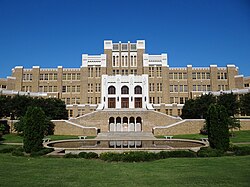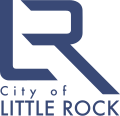| Little Rock Central High School | |
|---|---|
 | |
 Front entrance to Little Rock Central High School | |
| Location | |
 | |
1500 Little Rock Nine Way [1] 72202-5843 United States | |
| Information | |
| School type | Comprehensive public high school |
| Founded | 1927 |
| Status | Open |
| School district | Little Rock School District |
| NCES District ID | 0509000 [2] |
| Superintendent | Dr. Jermall D. Wright |
| CEEB code | 041422 |
| NCES School ID | 050900000607 [2] |
| Principal | Nancy Rousseau (since 2002-present) |
| Teaching staff | 161.18 (on FTE basis) [2] |
| Grades | 9–12 |
| Enrollment | 2,260 (2023–2024) [2] |
| Student to teacher ratio | 14.02 [2] |
| Education system |
|
| Classes offered | Regular, Career Focus, Advanced Placement |
| Hours in school day | 7.25 |
| Campus size | 18 acres (7.3 ha) |
| Color(s) | Black and Old gold |
| Fight song | On, Tigers! (based on On, Wisconsin!) |
| Athletics conference | 7A/6A East (2012–14) |
| Team name | Tigers |
| Rival | Little Rock South West high school, Cabot high school |
| Accreditation | ADE AdvancED (1924–) |
| Publication | The Labyrinth |
| Newspaper | The Tiger |
| Yearbook | The Pix |
| Communities served | Little Rock |
| Website | www |
Little Rock Central High School | |
Location in Arkansas | |
| Location | Little Rock, Arkansas |
| Coordinates | 34°44′12″N92°17′56″W / 34.7368°N 92.2989°W |
| Area | 17.95 acres (7.26 ha) |
| Architect | Parks Almand, John |
| Architectural style | Gothic Revival |
| Visitation | 44,293 (2005) |
| Website | Little Rock Central High School National Historic Site |
| Part of | Central High School Neighborhood Historic District (ID96000892) |
| NRHP reference No. | 77000268 [3] |
| Significant dates | |
| Added to NRHP | August 19, 1977 |
| Designated NHL | May 20, 1982 [4] |
| Designated CP | August 16, 1996 |
| Designated NHS | November 6, 1998 (#01000274) |
Little Rock Central High School (LRCH) is an accredited comprehensive public high school in Little Rock, Arkansas, United States. The school was the site of the Little Rock Crisis in 1957 after the U.S. Supreme Court ruled that segregation by race in public schools was unconstitutional three years earlier. This was during the period of heightened activism in the civil rights movement. [5]
Contents
- History
- Early campus history
- Little Rock integration
- Teaching evolution
- After integration
- Academics
- Publications
- Awards and recognition
- Extracurricular activities
- Athletics
- Feeder patterns
- Elementary schools
- Middle schools
- Little Rock Central High School National Historic Site
- Notable alumni
- Academia, public service, and politics
- Arts and entertainment
- Commerce and industry
- Military
- Sports
- References
- Further reading
- External links
Central is located at the intersection of Little Rock Nine Way (a section of Park Street, designated in September 2022) and Daisy L. Gatson Bates Drive (formerly 14th Street). [6] Bates was an African-American journalist and state NAACP president who played a key role in bringing about, through the 1957 crisis, the integration of the school.
Central can trace its origins to 1869 when the Sherman School operated in a wooden structure at 8th and Sherman streets; it graduated its first class on June 13, 1873. In 1885 the Sherman School was moved to 14th and Scott streets and was named Scott Street School, but was more commonly called City High School. Five years later in 1890, the Peabody School was constructed at West Capitol and Gaines streets. It was named in honor of philanthropist George Peabody from US$200,000 received via the Peabody Education Fund. In 1905, the city founded Little Rock High School at the intersection of 14th and Cumberland streets, and shuttered the Peabody and Scott Street schools to serve as the city's sole public high school. Until 1957, only white students were permitted to be enrolled.
In 1927 at a cost of US$1.5 million, the city completed construction on the nation's largest and most expensive high school facility, which remains in use today. In 1953 with the construction of Hall High School, the school was renamed as Little Rock Central High School. It has since been listed on the U.S. National Register of Historic Places and named as a U.S. National Historic Landmark and National Historic Site.
Central High School, which covers grades 9 through 12, had an enrollment of 2,476 in school year 2020–2021. [2] It is in the Little Rock School District, and serves sections of Little Rock and the entirety of Cammack Village. [7] [8] Nancy Rousseau was appointed principal in 2002, and retained that position as of 2024 [update] . [6]









